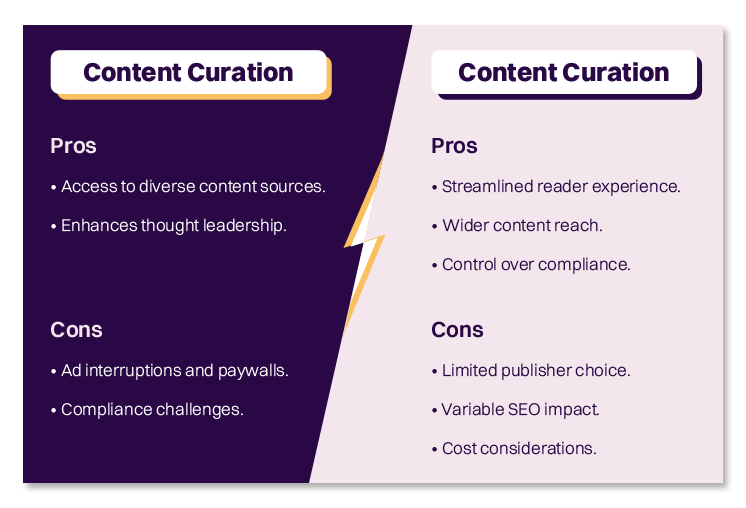
Content Syndication and Content Curation: Finding the Balance
B2B content syndication empowers your business to expand its reach. How? This vital demand-generation strategy distributes your content through email campaigns and direct interactions with key contacts. 79% of marketers use at least one vendor for their content syndication.
Meanwhile, content curation involves discovering, selecting, and disseminating relevant and valuable content from external sources. The shared content is given due credit and attribution. 85% of B2B content marketers use it for their organizations’ success.
These content distribution strategies are incredibly potent tools for your brand to nurture leads and establish credibility. However, you must know how to balance these approaches correctly. And this is what we will discuss in the following sections.
8 Differences Between Content Syndication and Curation
Let’s first explore the key differences between content syndication and curation:
| Content Syndication | Content Curation | |
| Definition | Distributing your existing content to a broader audience via 3rd-party channels. It involves sharing your content outside your primary platform. | Gathering and sharing valuable content from external sources, often with your insights and commentary. It involves aggregating content from diverse sources. |
| Purpose | Primarily for self-promotion, aiming to generate traffic, leads, and brand exposure by broadcasting your content. | Focused on enhancing the audience's experience by sharing relevant, high-quality content along with your insights. |
| Goals and Metrics | Focus on lead generation, nurturing, and increasing brand exposure. It enables reaching a wider audience with your own content. | Focus on thought leadership and providing added value to your audience. It positions you as an industry expert through curated insights. |
| Examples | Blog posts, articles, videos, infographics, and other resources created by your company, distributed on third-party platforms. | Industry news, articles, research, and insights from external experts are shared on your social media profiles, blog, or through email newsletters. You act as an information hub. |
| Ownership | Typically, your original content is created and distributed via reputed platforms. | Involves content produced by external sources, which you discover, organize, and share. |
| Resource Allocation | Resource-intensive, may require proactive engagement and outreach with third-party platforms. | More resource-efficient as it leverages existing content and the work of others, with a focus on content selection and commentary. |
| Control | Have control over the content, messaging, and distribution platforms. Effective for branding and lead generation. | More of a curator than a creator, you choose content to curate and provide context. Limited control over content creation. |
| SEO Impact | Directly contributes to SEO through backlinks, enhancing website authority and visibility in search results. | Indirectly benefits SEO by driving traffic and increasing user engagement on your platform, signaling content relevance. |
Pros and Cons: Content Syndication Vs. Content Curation
Next, for a better understanding, let’s discuss the advantages and disadvantages of both these approaches:
 Pros of Content Curation
Pros of Content Curation
- Access to a World of Content: Content curation allows you to tap into various topics and articles worldwide. Your ability to provide what your audience needs hinges on your access to diverse content.
- Thought Leadership Development: Curation showcases your interests and commitment to your readers' interests, enhancing your thought leadership. By sharing expert opinions alongside your content, you build trust and authenticity.
Cons of Curated Content
- Ad Interruptions: Curated content often comes with ads and paywalls depending on the article or publisher, potentially impacting the reader's experience. Solutions to minimize extraneous advertisements can enhance the reader's journey and promote brand awareness.
- Compliance Challenges: Ensuring the curated content aligns with your brand values and voice can be challenging, particularly in heavily regulated industries. In such cases, you can use tools like UpContent and Proofpoint to help you comply with internal and external requirements.
Pros of Content Syndication
- Streamlined Reader Experience: Content syndication allows you to share your licensed content. It eliminates firewalls and ads readers might typically encounter.
- Wider Content Reach: You can distribute your articles on numerous reputed platforms. It expands your reach and attracts new audiences to the content they enjoy in your controlled environment.
- Control over Compliance: Syndication makes compliance management straightforward because you can control the reader's experience.
Cons of Content Syndication
- Limited Publisher Choice: Content syndication often requires agreements with publishers. Many syndication agencies offer limited publisher options, potentially compromising the trust-building process.
- Variable SEO Impact: Syndication's SEO benefits can be inconsistent. It does allow you to host content on a subdomain managed by your syndication vendor’s system. However, it may not directly impact the performance or visibility of your original content.
- Cost Considerations: Syndication can be costly, typically involving fees paid to publishers. This cost can add up quickly depending on the number of articles needed. If the fee isn't paid directly to the publisher, it might be included in your monthly subscription to your outsourced content syndication platform.
Solution
With Revnew, you get the choice to share your resources on reputed publishing platforms. Moreover, we target only leads interested in your brand and its offerings. Hence, you easily generate more traffic to your website – resulting in higher SEO rankings. Finally, with our value-for-money pricing models, you need not worry about high costs!
Finding the Right Balance: 5 Tried-and-True Tips
Now that you know how content syndication differs from content curation, let’s explore how you can find the correct synergy between these two strategies:
1. Assess Your Content Mix
You must understand the ratio between syndication and curation. There's no universal formula. However, here are some well-researched suggestions:
Tip 1:
Our experts suggest that you have most of your content as original (syndicated) and supplement it with curated content. This dynamic balance ensures you broadcast your voice and content offerings with diverse perspectives.
For example, Magee Clegg, CEO of Cleartail Marketing, recommends a 60:40 ratio of original to curated content for a balanced content strategy.
Tip 2:
According to a report, the ideal content marketing mix is 65% created, 25% curated, and 10% syndicated content.
PRO TIP: To determine the right content mix, align your goals, audience preferences, and available resources. Experiment, monitor performance, and adapt as needed. Seek industry insights and expert advice to craft a flexible, customized content strategy that balances syndication and curation effectively.
2. Consider Relevance and Quality
Regarding syndication, ensure your content aligns with your brand and adds genuine value to your audience. In curation, select content highly pertinent to your niche or industry. This selection process helps in establishing your content's authority and trustworthiness.
3. Maintain Consistency
Keep a steady publishing schedule for both content syndication and curation. This consistency helps your readers to keep note of their expectations. Plus, it builds trust with your audience and keeps them engaged. They'll come to expect and look forward to your content, knowing that they can rely on you for valuable insights.
4. Monitor Performance
Regularly evaluating the performance of your syndicated and curated content is essential. Leverage analytics tools to measure key metrics like lead volume, ROI (Return on Investment) and lead conversions. This data will guide your content strategy adjustments, ensuring your efforts yield the desired results.
5. Embrace Collaborations
Don't go it alone. Collaborating with industry peers can magnify the impact of both syndication and curation. Consider mutual content syndication arrangements and curate insights from your partners. This cross-pollination broadens your reach and enriches your content with different perspectives and expertise.
Final Word: Crafting a Unified Content Strategy
Consider merging content creation and curation into a cohesive strategy to strike the perfect balance. Original content showcases your expertise, leadership, and brand voice. On the other hand, curated content keeps your audience engaged between original creations.
Developing a content calendar that combines both types of content ensures a steady flow of information without overwhelming your audience. This approach aligns your content strategy with your business goals, fostering a holistic and sustainable approach to content management.
If you want more insights on balancing your content marketing strategies, it’s best to seek advice from a reliable content syndication agency. Or, you can schedule a discussion with our experts at Revnew. They will be happy to guide you.




